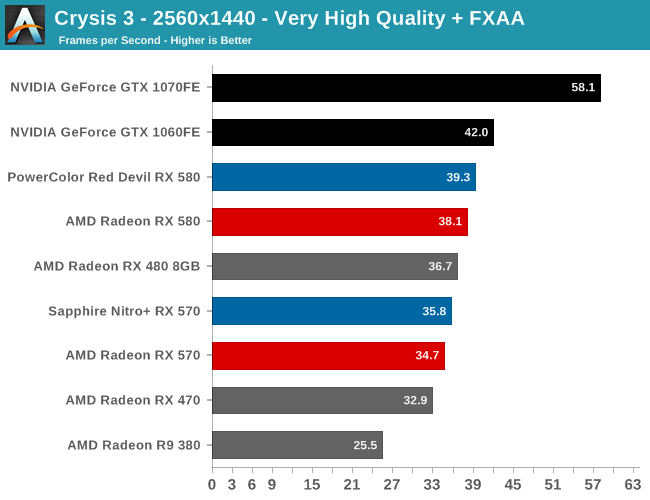The AMD Radeon RX 580 & RX 570 Review: A Second Path to Polaris
by Ryan Smith on April 18, 2017 9:00 AM EST- Posted in
- GPUs
- AMD
- Radeon
- Polaris
- Radeon RX 500
Crysis 3
Still one of our most punishing benchmarks 3 years later, Crysis 3 needs no introduction. Crytek’s DX11 masterpiece, Crysis 3’s Very High settings still punish even the best of video cards, never mind the rest. Along with its high performance requirements, Crysis 3 is a rather balanced game in terms of power consumption and vendor optimizations. As a result it can give us a good look at how our video cards stack up on average, and later on in this article how power consumption plays out.












129 Comments
View All Comments
Outlander_04 - Thursday, April 20, 2017 - link
The power difference you are talking about is roughly equivalent to that use by a dim light bulb.And yes lower is better ,but in many situations its not wasted power at all .
If, for instance, you are heating your home, then the extra wattage is always offset by the thermostat which will add less heat and use less power .
Mostly this is not a huge deal that fanboys try to make it
silverblue - Sunday, April 23, 2017 - link
The difference in rendering approaches (and, consequently, power consumption) reminds me of the GeForce 2 GTS - Kyro II days where the GTS could win more than its fair share of battles, albeit with much higher power requirements and more complex hardware due to its traditional rendering engine. The 1060, in a similar comparison, would be like Kyro II on steroids - the Kyro II was conservatively clocked, had minimal rendering pipelines, and had standard memory because it didn't need expensive hardware to run rings around its real competitor, the GeForce 2 MX, so in this comparison, due to a more elegant and sophisticated solution, the 1060 has the power to beat out the 580 more often than not in 6GB form. However, whereas the whole industry didn't change its implementations to compete back in 2001 (STMicro cancelled the Kyro III), we now know that this has to happen if AMD is to compete at the very top end, meaning that NVIDIA's efficiency advantage may be short-lived.If STMicro hadn't killed off the Kyro III, perhaps we could've seen an industry shift much sooner?
I understand the argument about more heat from your PC offsetting heating requirements in the home, but I suppose it depends what the room is like. Additionally, if more heat is being kicked out in summer, if you live in a very warm place then surely it's going to add to the cooling requirements, not only of your PC but of the room itself? Higher energy requirements mean a more powerful PSU, of course. What's more, considering the lack of SLi on lower tier NVIDIA products, you either have to go high-end or get two Polaris-based cards, both of which are going to use a lot more energy and thus produce more heat. That might help keep your room warm in winter, but I wouldn't like to be in a hot room on a hot day with those puppies at 100% load. I can imagine similar arguments about getting an FX 9 CPU; heat your room in winter, then conveniently forget about warmer months. :)
Maybe I'm just splitting hairs here, any thoughts?
Seikent - Thursday, April 20, 2017 - link
I expected a mention to the great noise improvements in the conclusions compared to the last generation, even if the new card is very similar performance-wise.GoMoeJoe - Thursday, April 20, 2017 - link
Vegas ,,, or nothing.Mr AMD - Friday, April 21, 2017 - link
Recommending a 1060, while it's slower under DX12 and Vulkan.......Mr AMD - Friday, April 21, 2017 - link
Try to use more modern games, with the new API's, than your recomendation for the 1060 will be turned backOutlander_04 - Wednesday, May 3, 2017 - link
I think you hit the nail on the head .JRW - Friday, April 28, 2017 - link
A video card in 2017 that can't maintain 60fps at 1080P on Very High in GTA 5? No Thanks.Diogo - Saturday, May 20, 2017 - link
There are huge differences between your results and "The Guru of 3D" in some benchmarks.The video cards: GTX 1060 6 GB x Sapphire Radeon RX 570 Nitro+ 4GB
Hitman(2016): the nvidia card in your test is 1,2% faster in 1080p, while in the other test, the amd card is 34% faster. I can't understant why it is happening. Looking at the fps it seems that the GTX 1060 6 GB behaves identically, but amd card does not.
Ashes Of The Singularity: the amd card appear to be faster by 8% in the other test. Although, I am not sure if the two tests are the same because you have "Escalation" word in your benchmark.
In Rise Of The Tomb Raider there is a difference on the directx version, the amd card at dx12 runs faster, but it does not win over GTX 1060 6 GB (9% faster).
Looking at the test setup, one thing that i could find is that amd drivers are different.
AMD Radeon Software Crimson Press Beta 17.10.1030 x AMD Radeon Software Crimson Driver 17.4.2.
One point to notice: If "The Guru of 3D" results are right, by my calculation, the amd card is 8% faster than the nvidia card in dx12 games( 1080p ). And the performance is similar at 1440p.